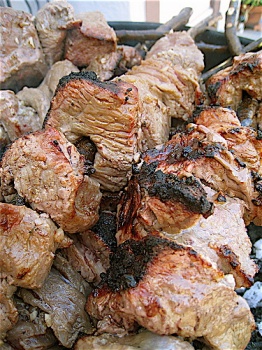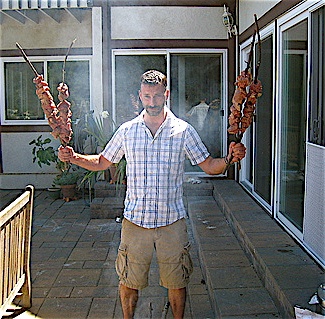This is just my small way of thanking Craig and Shannon and all of my fellow guests for all of their kindness. And fun. Oh, and absinthe.
I feel like one hell of a lucky guy.
Espetada
Serves 10 to 15 with an eye towards leftovers.

This Portuguese dish is the forefather of Brazilian Churrasco, which goes back to the days when Portugal was a major world player (read: a very, very long time ago.) Espetada is typically served with skewers of tomato, onion, and/or zucchini or other squashes. This preparation deals exclusively with the meat. I however, think that onion and tomato are important to the success of this dish. Especially the tomato. Rub a bit of the charred stuff on some bread which has been soaked in the meat juice. You will thank me for it, I promise.
Unless you are a vegetarian, of course.
Ingredients:
8 to 9 pounds of beef loin, cubed into 2-inch pieces.
1 whole head of garlic, chopped and ground into a rough paste
About 1 ½ cups Madeira wine (on the drier side. This is a Portuguese recipe, after all. Port, however, would be too sweet. Don't even think about using Marsala, because that's Sicilian. Besides, Sicilians aren't exactly famous for their beef dishes. Not that the Portuguese are either, but that is besides the point.)
½ cup extra virgin olive oil
1 cup (8 oz.) of butter, softened. Salted or unsalted.
Coarse salt. Kosher or Sea. Lots of it.
Crushed black pepper, to taste.
5 to 6 Bay Laurel* branches, ½ to ¾" in diameter and long enough to extend past the edge of your grill by 6" because you'll need a handle. Trim them of twigs and leaves; scrub them well.
1 to 2 loaves of rough country bread. Hearty is more likely the better word.
Preparation:
1. In a large, shallow baking dish, rub the cubed beef with garlic paste and crushed black pepper. Add the Madeira and olive oil to marinate. Cover and refrigerate at least 4 hours or overnight.
2. At least two hours prior to grilling, soak bay branches in cold water.
3. Cut a slit into each cube of meat and skewer onto branches. Cubes are allowed to touch each other. Leave about 6" on the ends of each branch meat-free, for purposes of handling the skewers when grilling time comes.
4. Once you have been liberated from the use of sharp knives, pour yourself some of the Madeira, as Craig suggests, just to keep in spirit. Drink.
5. Rub espetada generously with salt, but do not fully encrust. Cut bread into thick slices and line a large serving platter with them. Fire up your grill.
6. If you are grilling vegetable skewers as an accompaniment, grill them first, then unskewer and cover to keep warm.
7. Place your skewers 4 to 6" directly over a hot wood charcoal fire. We chose to remove the grill grate and be rather rustic. A grill grate, however, will ensure more even cooking. Rugged image or efficiency-- take your pick. Brush the meat with marinade as the mood strikes you. Cook until medium or whatever your preference. This is not, I should tell you, a rare-meat dish.
8. When meat has finished cooking, unskewer directly onto the awaiting platter of bread, covering as much surface area as possible. Dot the still-hot meat with softened butter to let it drip down the meat and soak into the bread. Let rest for about 5 minutes.
9. Devour.
*California Bay Laurel, our not-surprisingly local tree, has a much stronger flavor than European Bay Trees. As a result, the traditional rubbing of ground bay leaf into the meat has been omitted. As a fun, flora-geek side note, the California Bay Laurel, or Umbelluria californica, is also known as the Oregon Myrtle, the Pepperwood, and the Headache Tree.
 Last weekend, my oldest friends in the world threw a little potluck party for my birthday. While Shannon busied herself with preparing snarky party decorations, such as papering one wall with several copies of my 9th grade class photo (complete with braces and Sun-In orange hair) and supplying guests with empty thought bubbles to tape over my head, Craig took charge of the main event-- espetada. Guests were invited to bring food that I have discussed here on this website.
Last weekend, my oldest friends in the world threw a little potluck party for my birthday. While Shannon busied herself with preparing snarky party decorations, such as papering one wall with several copies of my 9th grade class photo (complete with braces and Sun-In orange hair) and supplying guests with empty thought bubbles to tape over my head, Craig took charge of the main event-- espetada. Guests were invited to bring food that I have discussed here on this website.